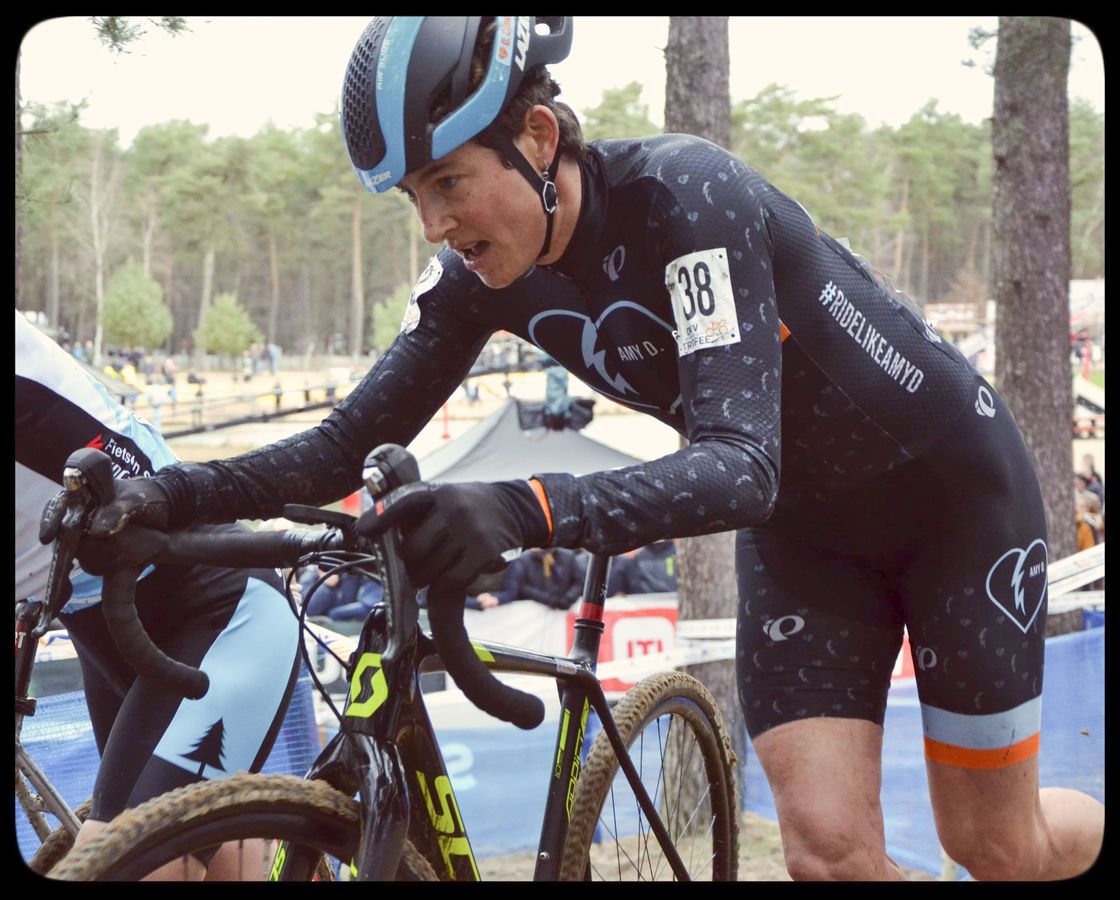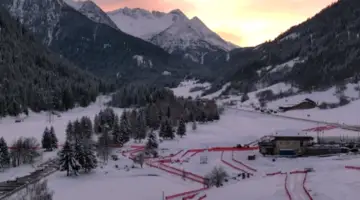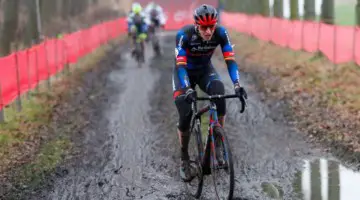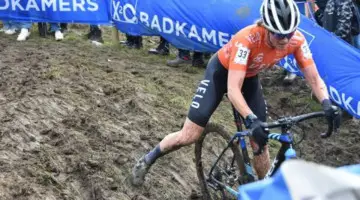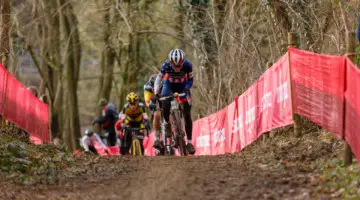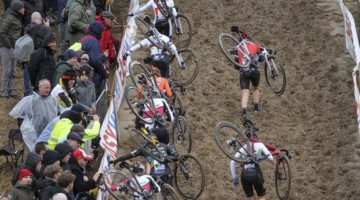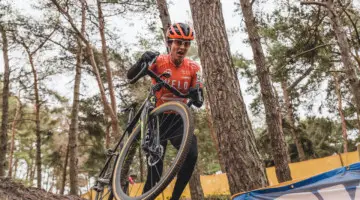My Belgian season is winding down. In the last week, I have done three races, and only two more remain on my calendar. I return home to snowy, bone-chilling Minnesota next week.
While others were in Denmark participating in or watching Worlds, I stayed “home,” did a training block and got a break from racing.
It was a bit of a sacrifice for me to miss all the fun that spectating Worlds would have been, but the payoff is sweet. My legs are great, I have re-found some snap I lost midseason, and I am healthy and well.
The Races
I am ready to post great results, yet I have been on the wrong side of luck as of late.
Midweek Cross – Brico Cross Parkcross Maldegem
The Wednesday following Worlds was Brico Cross Parkcross Maldegem.
It was typical of a midweek Belgian ’cross. These midweek races are smaller affairs with a community festival feel. They don’t lack for fans, beer or the omnipresent smell of frites. However, the crowds are not as maddening, the fans not as drunk, but it seems work has stopped and the whole community has turned out to watch.
Having not made “the big time,” a weekend racing slot, midweek courses tend to easier. They are more the Belgian field ’cross that gave veldrijden (field riding) its name. These courses don’t really suit me. I prefer races that require suffering, like Koksijde, where fitness and toughness are differentiators.
My top-20 result in Maldegem was solid and was good for some Euros in prize money. The event served as a good opener after some time away from racing.
The Weekend – DVV Trofee Lille and Superprestige Hoogstraten
I had extremely modest expectations for DVV Trofee Lille. Last year’s race in Lille may have been the physical and mental rock bottom in my season, and it’s hard to forget that.
On screen, I imagine Lille doesn’t look very difficult. There are no fearsome drops nor the epic sand stretches of Koksijde, Zonhoven or Mol. There are merely short sand stretches through very wet sand. It’s not a matter of plowing through the sand, but rather riding the ruts cleanly.
Last year my tactic went something like: go as hard as physically possible, burst out of the rut, get stuck in the sand, become frustrated, repeat.
This year, I raced as someone who had learned from her mistakes. While there are long straightaways for putting the power down, in the sand ruts, my mantra was, “Clean is fast, fast is clean.”
I was putting together a race to be proud of … until I broke my chain on the second to last lap.
The chain break is on me. I should have decided to replace the chain sooner. Likewise, I should have pitted when I first felt chain suck occurring. Instead, I had a nice long run to the pit.
Yet, here’s where my Dutch knowledge paid off—as I made my long run, I heard spectators discussing my gebroken ketting (broken chain).
Sunday’s Hoogstraten Superprestige stood out as a target race for me. Even in the driest of dry years (which is exactly what we have had this year in Belgium), it’s always a mudder. With my much-improved strength, I am much better able to handle a “tractor pull,” and my running is my best asset.
Hoogstraten should have been great … but it wasn’t.
On the middle of the first lap, I overcooked a corner and went down. Then I got back up, remounted and discovered my chain had dropped. I put my chain on—a process that’s never fast enough—and restarted. At this point, I was dead last.
From there, I had an amazing race, moving up more than 15 positions. Sometimes anger can be fuel.
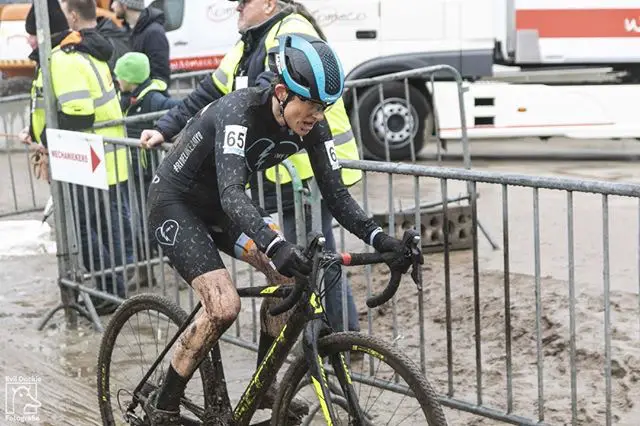
An early crash marred Coogan Cisek’s race at Hoogstraten. Corey Coogan Cisek Rider Diary. © Hans van der Maarel
Again though, I own my mistake. It rained steadily between preride and the start of the race. The tires I selected had too little traction for the now greasy corners. I should have switched back to muds. Likewise, I could have adapted my cornering to keep my wheels more upright.
Sport is hard. There are so many moving pieces that need to go right in order to produce one’s best result. This year, I am ending the season with great form. Yet, two relatively small equipment mistakes I made prevented me from showing that form.
Surviving and Thriving in Belgium
I think at this point, it’s safe to say (without too much knocking on wood), that I’m going to end this Belgium trip fit, healthy and well.
Somewhere along the way, Belgium became easier for me. I feel truly and completely at home here. Living here and racing here is suddenly no more difficult than being an athlete back home. In fact, given my Belgium support network, it might even be easier.
How long does it take to adapt to European life and racing? For me it was two trips and six months.
In celebration of this new steady state, “life is good” place that I have reached, I offer you three tips for quick acclimatization and success in Belgium.
1. Accept Help
Last year, shortly after I arrived in Belgium, Elle Anderson reached out to me and offered me some valuable advice. As I recall, she said something like: “I just want you to know that you can ask for help. You don’t have to do it alone. It’s a mistake to try to do it alone.”
Naturally, I did what we often do with great advice: I listened and then completely failed to follow it.
Also early in last year’s trip, a Belgian friend offered to go to the bank and get an account set up in my name. I declined, explaining I thought it was an important part of the experience to work through challenges like setting up a bank account.
In hindsight, I was foolish.
I had my mechanics, and they paved the way for me to a certain extent, but I did most everything on my own, even this year. I traveled solo, lived solo, drove solo and mostly figured things out on my own.
The other day I had a lightbulb moment. I met Erica Zaveta as she arrived at the ChainStay cycling house for her Belgian stay. I was there when owners Gregg and Holly welcomed Erica. Discussing groceries, Gregg reminded us that it was Sunday afternoon and the stores were gesloten (closed).
I remembered my very first trip to Belgium, a short Kerstperiode trip with my husband. We arrived on Christmas Day and learned the inconvenience of Belgium the hard way. I’ll never forget my husband’s assurance, “Oh, there will be something open on Christmas.”
How much easier life would have been if we had stayed at the ChainStay that first time and could have relied on Gregg and Holly for advice.
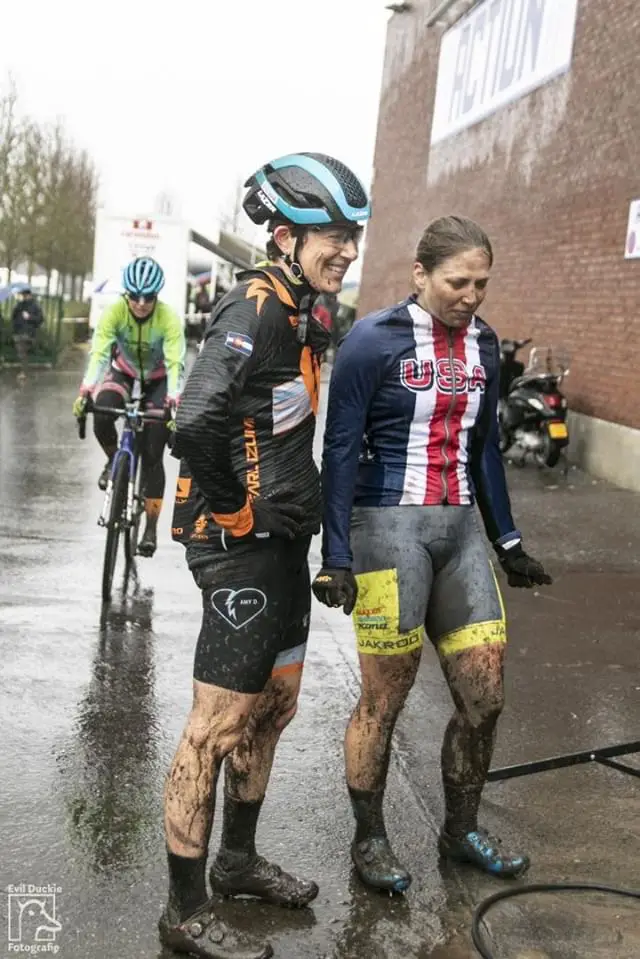
Belgium is challenging. Don’t be afraid to ask for advice. Corey Coogan Cisek Rider Diary. © Hans van der Maarel
It turns out Elle hit on the most important piece of advice. Don’t go it alone. Ask for help. Depend on others.
In retrospect, I am glad I did things the hard way. One of my goals was to “learn Belgium,” so as to eventually coach and/or direct and help American riders to succeed in Belgium. Lessons learned the hard way are often longer lasting.
Nevertheless, my DIY attitude hindered my acclimation to this place and slowed my progress as a racer.
There’s been a large contingent of North Americans here since December. Some have tried to do it on their own, to be self-sufficient. I’d argue that those who have lived amongst other Americans and who have relied on local support have had better results. They are also looking less harried around the edges at this time of year.
2. Hire a Local Mechanic
Speaking of relying on a locals, don’t think twice, hire a local mechanic.
During that first Kerstperiode trip I spoke of earlier, my husband was my mechanic. Spoiler alert: we are still married, despite the experience.
As my husband will attest, even finding the pit (often there are two) can be difficult. Between the two of us, we spent countless tiring hours managing my bikes. Upon returning home, both my bikes needed a costly overhaul.
When I returned a second time, again a 10-day trip, I hired a local mechanic. At first, the cost seemed exorbitant, but sanity … well, that seemed priceless.
I was in for a good surprise. Not only did my bikes run perfectly the whole trip, but they didn’t need any repairs when I returned home. The lack of repairs completely offset the cost for the mechanic.
A good mechanic will clean your bikes between pre-rides, and not just clean them, but fully lube them. This treatment extends the life of bearings and cables. Likewise, the psychological impact of riding a clean bike is significant. A pre-ride on a heavy gritty bike is rather like warming up into a headwind when it comes to your confidence.
Every pro should arrive in Belgium with a full bag of spare parts. Yet, regardless of how many you bring, rest assured you will need something, invariably over Kerstperiode or on a Saturday evening when not a single bike shop is open.
A local mechanic with a network of cycling business friends can source a part at 10:00 p.m. on a Saturday. Ask me how I know.
I work with the support service Cyclocross Custom. They offer onsite mechanical and cleaning support, as well as staff to pick up clothing at the start and tents to warm up under.
You know that thing in America where you put your bundle of warm-ups under the start fencing and feel relatively assured it will be there when you get back? Well, that is not a thing in Belgium. Again, on my first trip, my warm-ups became “fan souvenirs” when I tucked them into a bush.
3. Hire a Coach who Knows Europe
European ’cross is surprisingly different from its American cousin. Tractor-pull mud and wet, sticky quicksand require high force, low cadence efforts. Short steep ups, as well as stupidly steep flyovers, require repeated max power efforts. Numerous tight turns separated by straightaways call for repeated out of the saddle efforts (the number of which per lap we don’t have in the U.S.).
Then there is the running…
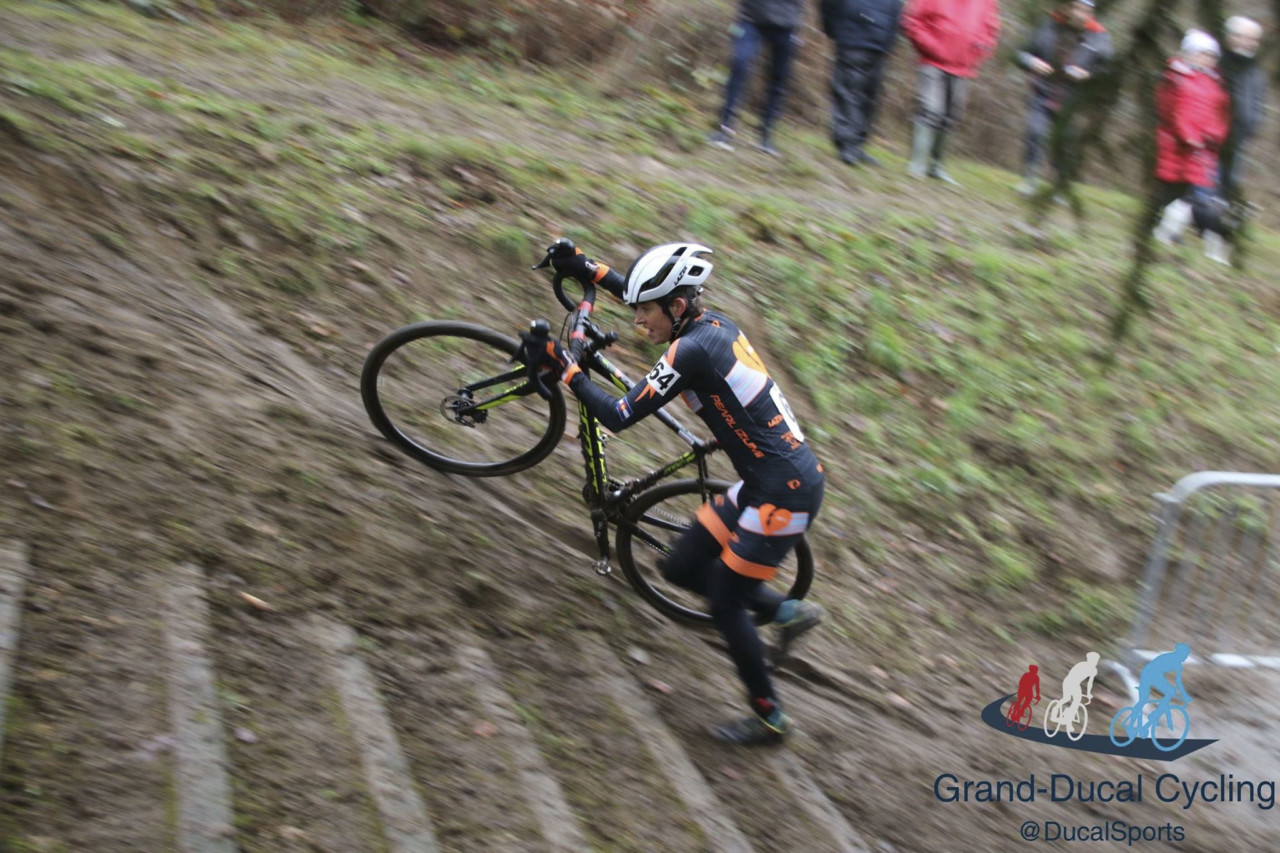
The running is just part of the European cyclocross experience. Corey Coogan Cisek Rider Diary © Grand Ducal Cycling Photography
A cyclocross racing season is a challenge to manage in any country. With all the racing and associated rest, it’s hard to fit in any training. We are always “more fit” in September than we are in January. The reality of cyclocross is that we are all on our way down. It’s just a question of how fast.
Managing fitness and form is all the more difficult in Belgium where most of the races are brutally hard and very physical. I often finish races bruised from the ground, fencing and hauling a mud-laden bike around in awkward ways. Add to this winter weather in Belgium where ice, wet snow or unrelenting cold rain can impact planned workouts.
I owe my late-season form and much-improved results here to Helen and Stef Wyman. Helen lived in Belgium for many years, and I think it’s a safe bet that she had plenty of challenges in her early years here. Because of their personal experience, they were able to create and adapt a training plan that suited the training environment and European racing. It was the right balance of training and rest.
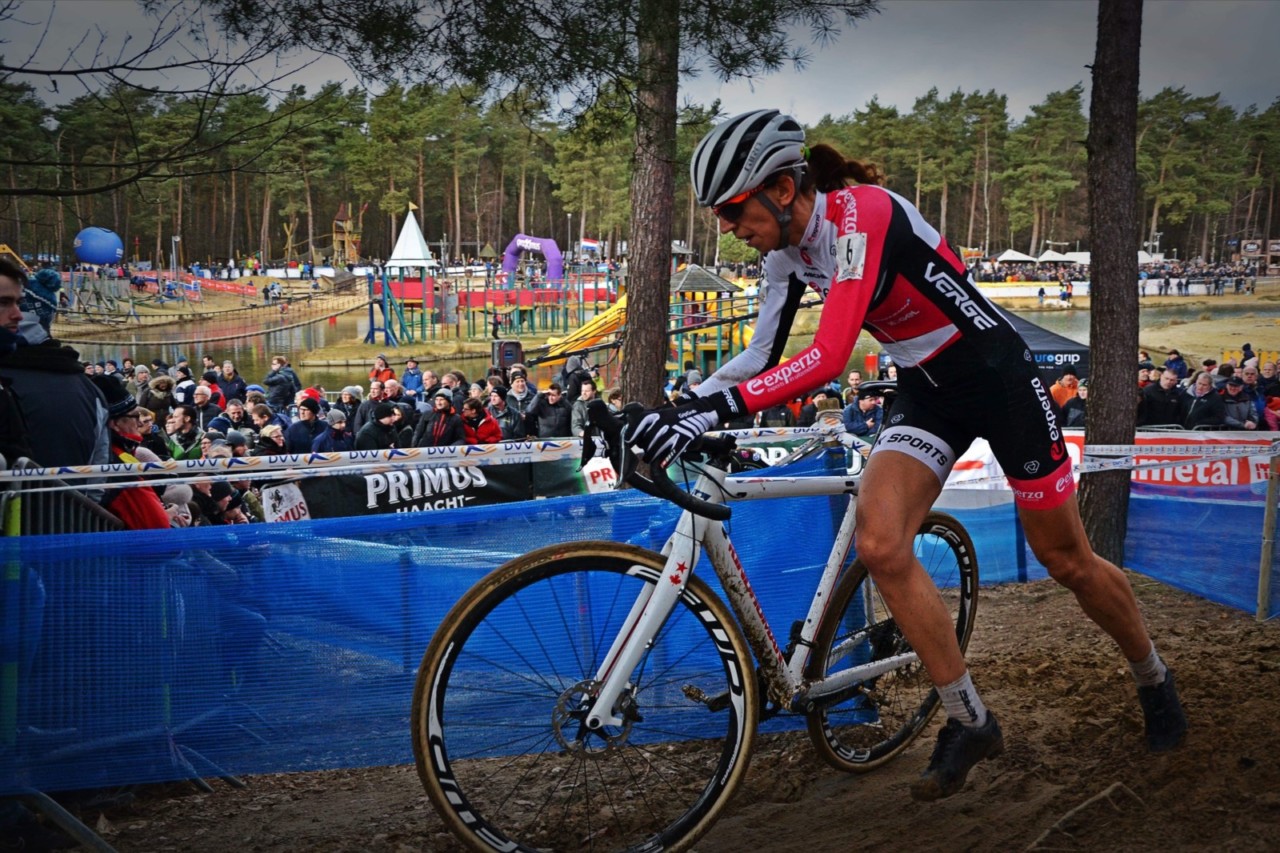
Helen Wyman’s years of experience have paid dividends for Coogan Cisek this season. Corey Coogan Cisek Rider Diary. © Emma De Poorter
Could a North American-based coach do the same? Certainly, but this would be very hard to achieve without significant on the ground experience here. Watching cyclocross streamed, reading about it and imagining it just isn’t the same as living it.
That is my quick and dirty advice for thriving while racing cyclocross in Europe. After two years doing the full immersion in Belgium, I cannot recommend it highly enough. As I learned though, definitely do not be afraid to ask others for advice. It will help you more than you know.
My 2018/19 Belgian adventure is now winding to a close. Just two races remain for me, Superprestige Middelkerke and Brico Cross Hulst.
The forecast? Highs in the 50s and an absence of rain. A nice way to say goodbye to Belgium before heading back home to the arctic tundra of Minnesota.














